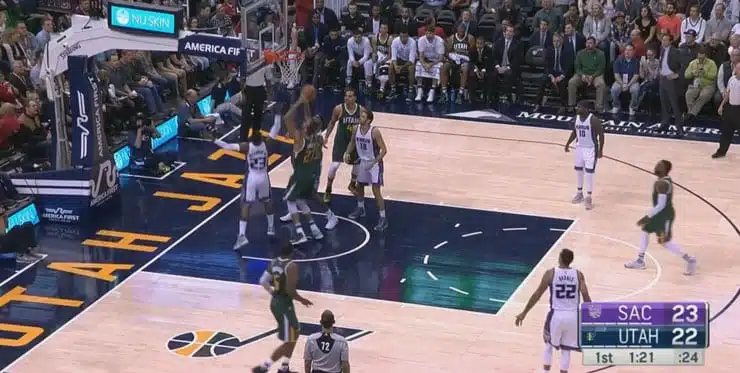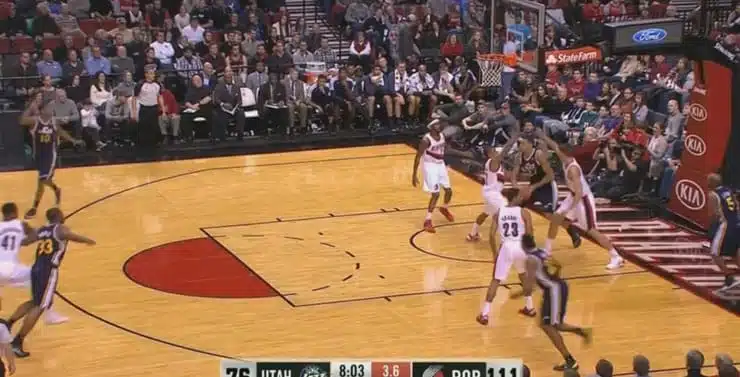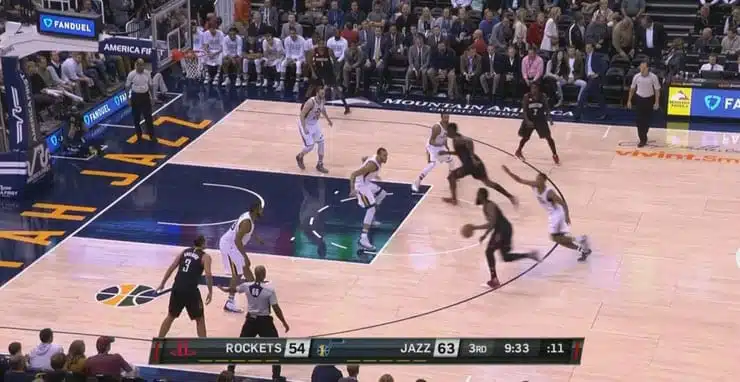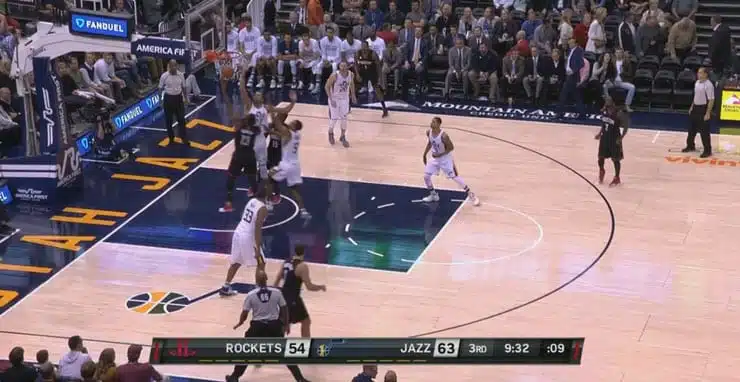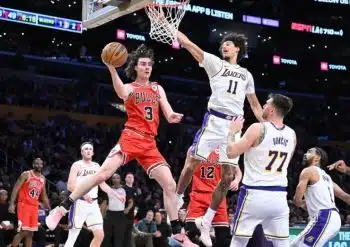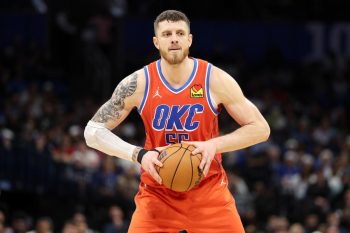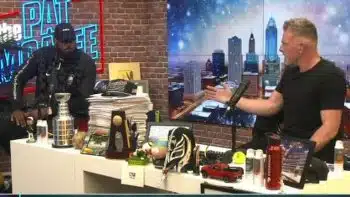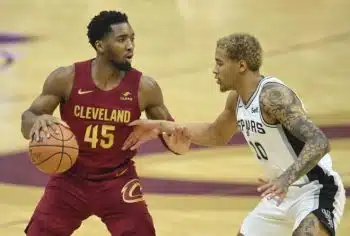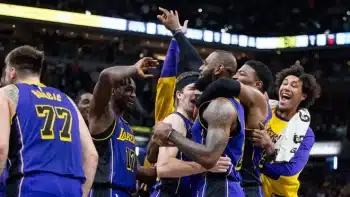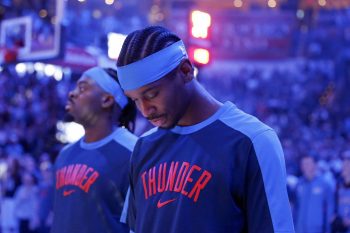NBA
Raw to Revered: Rudy Gobert’s Path to Stardom
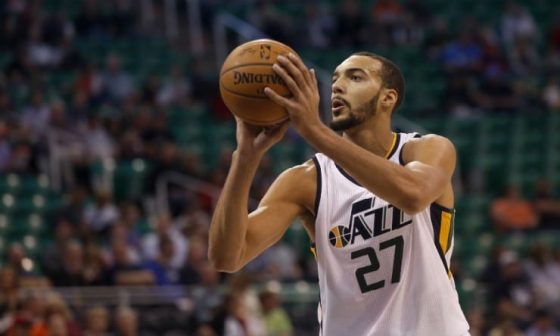
When you have a little spare time one day, go take a look at Rudy Gobert’s Twitter account.
It’s mostly innocuous, but a close enough look reveals a unique personality. A few weeks ago, Gobert turned the Jazz’s “#takenote” hashtag into his own slightly R-rated “#takefnnote” slogan, one that’s been picked up by Jazz fans everywhere. Two days later, he sent the “face with tears of joy” emoji to the NBA’s official account in response to a top defensive plays of the week video, which audaciously had left each of his roughly dozen swats on the cutting room floor.
For the best stuff, though, you’ve got to click on Rudy’s “Likes.” He mostly hits the heart button for a combination of diametrically opposed tweets: Those praising his prodigious accomplishments and, more tellingly, those slighting him in any way. Some are both simultaneously, in a way, and devoted Jazz Twitter-ites have long learned that informing Gobert of any diss he may not have been aware of could earn a heart.
The liked slights have become fewer and further between over the years, and the praise more common. Maybe Gobert himself would tell you it’s a result of a diligent Jazz PR staff looking to keep him within a generally conservative and understated fold in Utah.
Squint hard enough, though, and maybe it means something else entirely. Maybe this kid who once felt he had so much to prove has grown into a man who knows his play has done more of the talking (clicking?) than he ever could. Maybe whatever motivation Gobert finds from proving his doubters wrong just isn’t always as necessary anymore, replaced by organic success and a growing Jazz core around him. Maybe tiny changes over time on an ultimately silly social media tool are the perfect microcosm for this young career.
Gobert’s 21st birthday came the day before the 2013 Draft, but the next night in New York was a pretty lousy present.
He was a consistent lottery presence in DraftExpress mock drafts all through his 2011-12 season, and even rose to a top-five slot for over half of his pre-draft season in late 2012 before his slide began. Team workouts were the biggest issue, per scouts, including one in Oklahoma City where fellow center prospect Steven Adams was rumored to have dominated Gobert in a one-on-one setting. DraftExpress had him sliding all the way to 26 by the big day, one spot before he’d eventually be selected.
From Utah’s perspective, though, it felt like Christmas in June. The Jazz originally held the 14th and 21st picks in 2013 before trading both to move up to ninth and pick point guard Trey Burke. Gobert was squarely on their board at No. 14 while they still held the pick.
Jazz scouts saw a raw prospect, but one who had no bad habits and several good ones. Gobert seemed to genuinely enjoy beating slower big men up and down the floor, and this extended to several of the more grimy areas that every big man says they love to work in, but fewer actually do with any real enthusiasm.
They weren’t as worried about any workout concerns, mainly because they saw the ways this sort of player would be underrated by that environment. Take any version of Gobert, from draft day to present, and put him in a closed-gym, one-on-one workout with a scout who has never seen or heard of him before – here’s $5 to yours that the scout will naturally underrate his NBA success. Workouts are meaningful, but they struggle to pick up many of Gobert’s biggest strengths.
Once Utah’s trade to select Burke was finished, their eyes moved squarely to Gobert as he continued to fall down the board. There had never been much dissent in the Jazz’s draft room regarding their feelings on Gobert overall, but any doubt was removed as soon as he fell into the 20s. A hard worker with historical measurables, already capable of blocking shots and finishing dunks and without any major bad habits? It was a no-brainer for Utah, and the biggest hurdle at that point was finding the right trade partner.
Gobert chose No. 27 as his number, a constant reminder of how many teams looked past him. In retrospect, it was a pretty perfect introduction.
The NBA game has a habit of overwhelming young big men, and Gobert was no different. A preseason injury to Marvin Williams forced Rudy into immediate action, including nearly 23 minutes in his first ever NBA game. His physical ability was evident, but he struggled with the same leap in overall athletic quality that many young guys do.
“When I got in the league, the game – everything physically, in terms of speed and strength – I was surprised,” Gobert told Basketball Insiders. “I was excited, I was motivated, but it was tough.”
A player very used to making a constant impact on the game wanted to do the same right away in the NBA. Gobert’s hyper-activity wasn’t something anyone had to teach him along the way, and it got him into trouble at times as a rookie. Guys couldn’t be moved as easily at this level with a little sheer physical domination; those extra beats of open space that led to dunks in Europe were replaced by bodies and an unforgiving whistle.
His rawness translated into offensive mistakes that were pretty glaring to even the casual eye, but this may have given a false impression. Gobert saw the game well on both ends, but he needed much more time for his processing skills (and his limbs) to catch up to his raw basketball IQ.
“I think I was going too fast,” Gobert recalls.
That 22:54 he logged in his first NBA game would be the high water mark for Gobert on the calendar year of 2013, with his minutes decreasing and even disappearing for games at a time once Williams was back in the lineup. His first big change came when he was sent to Bakersfield in the D-League in mid-December.
“I hadn’t played for, like, two months,” Gobert said (not technically true, but Gobert had indeed been seeing DNP-CD designations for about half his games from then-Jazz coach Ty Corbin over the prior month or so). “And then I started playing in the D-League, and I was feeling way stronger, I was feeling way better. I dominated in the D-League.”
He’s not exaggerating at all. His first game in Bakersfield was a 16-point, 14-rebound, six-block showing in 32 minutes. He followed that up with a 16-point, 14-rebound, four-block performance.
He capped things off with 23 points and 14 rebounds in just 30 minutes in early January, finishing his eight-game D-League stint with a PER of nearly 28 and a field-goal percentage of nearly 75 percent. Gobert also shot 70 percent from the line, the first sign that he could make teams pay from the stripe when he was comfortable. He had been well under 50 percent in the NBA to that point, albeit on a tiny sample size.
Gobert rejoined the Jazz within the first month of 2014, and minute consistency continued to be a struggle. It’s no secret within the organization that Corbin’s priorities didn’t align with a player like Gobert, and perhaps not with the team’s timeline either. With an expiring contract that pretty obviously wasn’t getting renewed, Corbin was auditioning for the next stop. Gobert is diplomatic about it in retrospect, though.
“I think I just wasn’t in his plans, which is not a bad thing, you know, I got drafted 27th,” Gobert told Basketball Insiders. “Derrick [Favors] was playing good and Enes [Kanter], you know, so that was the plan, play those guys.”
Favors and Kanter might have made playing time tough to come by for Gobert under any coach, but the real issue with Corbin’s approach was how it clashed with Rudy’s long-term development. That rookie year is huge even for guys who aren’t seeing consistent minutes, and while no one within the organization will outright say so (burning bridges isn’t this front office’s style, even off the record), it seems fairly clear that bringing along this seven-foot Frenchman who wouldn’t be an integral NBA starter until long after Corbin was gone wasn’t high on Ty’s priority list.
Gobert found an outlet in assistant coach Alex Jensen, with whom he remains close to this day. He would come back to the team’s facility after practice in the afternoons every day and shoot with Jensen, and the two quickly developed a bond. Some in the organization directly credit Jensen for Gobert’s progress in that first year.
“Alex has been great for me since I got here,” Gobert said. “I would say he was one of the only guys that really, you know – not believed in me, I’m not saying Coach Ty [Corbin] didn’t believe in me, but [Alex] was a guy who was really wanting me to play and was working to try to get me on the court. And working with me every day… Even outside the court, he was always talking to me. That was great.”
Gobert found a few more extended stretches of minutes once he was back permanently with the Jazz, but they were mostly with Favors sidelined in January and February. He was on the keen-eyed Jazz fan’s radar, but generally as nothing more than a long-term project.
Corbin’s expected dismissal and all the resulting rebuild-related summer themes drove most of the summer narrative. The team was focused on a coaching search and Quin Snyder’s eventual hiring, two first-round picks and a roster configuration clearly aimed at handing the kids the keys.
Soon, though, Gobert started making his own noise. He started five games at Orlando Summer League, posting a 22 PER and a 10 percent block rate (a ridiculous figure he’ll never approach during normal NBA play, and few have ever accomplished).
Then suddenly, in the usual NBA September down time, Gobert burst on the national scene for the first time during the 2014 FIBA World Cup. His defensive showing against the Gasol brothers raised eyebrows as France upset Spain in the quarterfinals, eventually finishing third.
Gobert counts the experience as a big moment, and it gave him momentum heading into training camp. He had spent the rest of his non-playing summer building strength, especially in his legs, and he was ready for the longer run the team’s youth movement seemed destined to bring him as an intriguing third big. Training camp would unite him with Snyder and a whole new outlook on player development, and the ball was rolling.
There was something different right away with Snyder and Gobert. Guys don’t make the NBA without working hard, but Snyder was impressed by how Gobert’s on-court competitiveness carried into urgency in practice and even film sessions (which isn’t always a given).
“There may not be a more competitive guy, as far as how he approaches his work,” Snyder said of Gobert.
The two developed a bond immediately. Snyder is a details guy, and that’s exactly what Gobert’s game needed. This wasn’t a blank canvass of a player; Gobert’s biggest skills were already NBA-level, plus he’d already been honing the margins of his game with Jensen, who was retained on Snyder’s staff.
Hands were a bit of an early issue, an expected one for most given his size – but not expected for Gobert.
“I don’t think I ever had bad hands,” he told Basketball Insiders. “I think I was maybe a little nervous, and when you’re nervous, I was kind of surprised sometimes when I was getting the ball.”
“I never had problems catching the ball when I was younger,” he reiterated. “I just think it was physical, and the speed of the game.”
He also wasn’t exactly in the ideal environment to build his confidence catching the ball as a rookie. Those 2013-14 Jazz gave the bulk of the ball-handling duties to a rookie in Burke and several 23-or-under guys who, outside Gordon Hayward, pretty clearly weren’t ready to initiate an NBA offense yet. Their only veteran ball-handlers were John Lucas III and Jamaal Tinsley, two journeymen who combined for under 300 NBA minutes after that season (all from Lucas).
Gobert dropped his fair share of gimmes, but he was also trying to build up his confidence on a steady diet of unhealthy looks.
Gobert also lacked one big fundamental skill that may seem simple, but can flummox plenty of big men for most or all of their careers: He couldn’t keep the ball high. It’s a natural movement to bring the ball down to your chest or even lower to gather for a shot, even most dunks, but Gobert was getting into trouble as a rookie when he’d keep the ball too available for reaching hands.
Whether it was a Snyder or Jensen emphasis or something else entirely, though, that summer between his rookie and sophomore years seemed to rid a lot of those issues from his game. Gobert’s strength work also played a big role.
“The main thing was also getting stronger, getting my legs stronger, be able to not get pushed around as much,” Gobert said. “And be able to make my move and slow down.”
They were subtle differences. He was still seeing his share of low passes, but he was catching them more effectively and doing a much better job getting the ball back up where quicker hands couldn’t interfere.
Rudy’s turnover percentage dropped nearly seven full points between his rookie and sophomore seasons, and he shaved over a full cough-up from his per-100-possession averages.
Fast forward that to this season, and the progression of a hard-working big man becomes evident. It was second nature for Gobert to bring that ball all the way back down before he re-gathered as a rookie; a few thousand reps later, it would feel foreign for him.
Here’s the lowest point the ball ever reaches on that put-back layup against the Kings from earlier this year:
Compare that to where the ball was right before Gobert gathered to go back up during his rookie year:
With that big confidence boost came trickle-down to the rest of Gobert’s game, on both ends of the floor. His smoother hands meant he could be more of a factor offensively, especially in the pick-and-roll game, a realization his teammates came to quickly. Gobert received more passes by the end of November in his second season than he did for the entirety of his rookie year, per SportVU data (in barely over half the equivalent minutes), and was finishing assisted baskets at nearly double his rookie rate.
“I always wanted to build that connection with my teammates,” Gobert said. “I think [I] had a great connection with Dante [Exum] in my second year. He was finding me a lot, and giving me a lot of confidence.”
Exum, fresh into his own new role as a starter early into his rookie year, assisted on more Gobert baskets than any other Jazz player that season. The young Aussie started finding Gobert at angles where other guys previously hadn’t been considering him an option.
With his improved hands came improving footwork, a combo that made Gobert into an offensive threat simply by putting him in the right places and daring defenses to leave a single guy trying to jump higher than him for the ball. He was always an eager screener as a rookie – sometimes a bit too eager, perhaps.
As the game slowed down, though, Gobert found his literal and metaphorical footing. He learned how to properly vary his screen-and-roll game – when to slip the screen for a quick rim run, when to hold long enough for contact, when to re-position and set another pick.
The ball-handler and roll man in pick-and-roll are engaged in a constant ballet, where one affects the other’s timing and vice versa. Gobert found ways to make himself more presentable by timing his runs better, and mastered the pivot-and-turn that’s often necessary for the big man in these sets.
“Rudy puts pressure on the rim,” Snyder said. “It’s ironic, but he actually really affects your spacing. By rolling to the rim, he impacts your spacing, because people have to come in [and help]. So really I should say, impacts the effectiveness of your spacing.”
That impact has been evident in the numbers. This is now the second straight year the Jazz have been a much better three-point shooting team with Gobert on the floor than with him off, despite the fact that he hasn’t attempted a single triple himself in this time. They’re a borderline top-five three-point shooting team this year by accuracy with him, and a borderline bottom-five outfit when he sits.
Footwork was vital for Gobert on the other end of the floor as well. SportVU data tells us that once he got there to contest, he was an elite rim protector from the moment he stepped foot on an NBA court as a rookie. The 42.2 percent he’s allowing this year is the league’s stingiest mark among volume defenders, but it would actually be his highest mark allowed in four full seasons if the year ended today. Smart teams have long stopped going at him in the post, where he’s allowing 35 percent from the field over the last two seasons, per Synergy Sports. He’s at a gross 27.5 percent allowed as the primary post defender this year.
The rub for Gobert, though, was striking the right balance as a help defender. Early on in Snyder’s tenure, he’d either be too aggressive or too timid – and the two relate.
“There [were] times where he’d kinda hug his man,” Snyder said. “We’re all human. Rudy looks up, and he’s come over to help, and all of a sudden his guy’s got 10 points and six rebounds because he’s leaving him, and he’s not getting help, and he’s more reluctant to leave.”
The best coaches in the world can scream themselves hoarse around skills like these; some guys are going to pick them up, and some guys just aren’t. There’s no set checklist for when these feel elements really click. Snyder never worried much about Gobert becoming one of those physical specimens who never puts it together, though.
“He pays attention to everything,” Snyder said. “He’s very aware. It’s probably one of the reasons he’s such a good shot blocker. There’s an awareness, an alertness and an urgency to who he is as a person, and that fuels him.”
Slowly but surely, Gobert started to fine-tune his instincts. His per-minute rim contests dipped between his first and second seasons as he flushed some of his over-pursuits and focused on staying home, then dipped even further during his 2015-16 season – a reality likely influenced in large part by a midseason MCL injury.
“I don’t think I was 100 percent when I came back, but I gave it my best,” Gobert told Basketball Insiders. ”I’ve never had knee problems, so I was kind of scared when I came back. Especially me, I move everywhere, I like to jump, like to push.”
Now, with another summer of strength work and work around the margins, Gobert hasn’t just found his happy medium – he’s begun to push the boundaries of how widely an interior big can impact the game, especially in today’s modern, pace-and-space world. He remains an uber-elite rim protector by percentage allowed despite being present to contest more per-game shots than anyone else over a full season in the public SportVU database. The Jazz play at a bottom-three pace, making this even more remarkable, and these numbers are barely even the half of it.
Take a late November game against the Houston Rockets. With the Jazz leading by 12 points at the half, Snyder did something very few coaches have ever done against this Rockets team: He invited Houston to play two-on-two with James Harden in the pick-and-roll.
Harden is probably the most devastating pick-and-roll player in the game with his array of floaters, foul-draws and exquisite passes, but Snyder was confident. With extremely limited team help, he stuck George Hill or Rodney Hood on Harden, Gobert on the roll man (both Clint Capela and Nene for stretches), and let the chips fall.
The Rockets attempted just nine threes during Gobert’s time on the floor during this second half, a per-minute rate over 25 percent lower than their league-leading figure. Snyder’s gambit worked in that department: Several of these were long, contested threes up against the shot clock.
Meanwhile, Harden got just enough of his to make his stat line respectable in the half – but nowhere near enough to call Snyder’s bluff. It took him 13 shots to get to 16 points, and he had just three assists to two turnovers. The discerning statistician questions whether Gobert was truly the chief cause; anyone who watched the game has no such concerns.
Know that there are maybe two or three other players in the game capable of doing what Gobert did here to block that Harden layup – and maybe none. His awareness is second nature at this point, and he knows Hill is going to slide down and give Capela a little nudge, so he stunts quickly at Harden to prevent him from taking the open midrange J.
Then he recovers, and note again: This is a full bore two-on-one to the basket, featuring MVP frontrunner James Harden and one of the better rim finishers in the league in Capela. Gobert has both options contained at the same time, and look where Utah’s three-point defenders are able to stand because of it.
Finally, it’s too late – even if Harden wanted to loft the lob to Capela, how exactly is he making that happen?
A defender is never complete at this level, but it’s a tempting designation for Gobert after a long journey. He sits near or atop every major defensive catch-all metric, and he wears the crown as the league’s best interior defender until someone takes it from him.
“His focus is so, so consistent,” Snyder says. “And when that happens – for any of us – you just become much more formidable. You don’t take plays off, and I think that’s what we’re seeing. We’re seeing some more maturity, and I think it will continue.”
The focus on Gobert has shifted recently.
No one takes his defense for granted, per se, but it’s less of a surprise than ever. You hear more about the other side of the ball, and these days you hear talk about which league-wide award he should be in the running for.
Both are justifiable topics. An offensive surge may seem unexpected to the naked eye, but it’s a clear product of that work on his hands, feet, timing… and most of all, confidence. It’s this last element people around the team claim was bolstered even more than the average guy by a new mammoth extension signed this offseason.
It’s not the dollar amount, really; Gobert is anything but a money-grubber. Folks in the know say Rudy’s loyalty to the franchise stretches back to that fateful day in June 2013, and that in some ways his big extension was a confirmation of that loyalty from both sides – one that freed up any little lingering pressure Gobert may have felt heading into this season.
Suddenly, he’s making on-the-run catches he couldn’t have dreamed of while standing still as a rookie… and dunking on guys whose physicality might have given him pause before this year.
Gobert is shooting his highest mark from the line in his career, pushing 65 percent on nearly six freebies a night.
“He’s going to shoot our technicals soon,” Snyder joked pregame recently.
The Jazz have started using him as more than just a dive man, too. Teams exploited Utah’s Gobert-involved pick-and-rolls in previous years by blitzing ball-handlers, daring the Jazz to get Gobert the ball in space and counting on his limited off-the-dribble skills to make their gamble worthwhile.
Now, the Jazz are bypassing the trap altogether. They’ll position another wing as a safety valve for the original ball-handler, and if teams leave Gobert a lane, he’ll simply ram his ass into his man, seal him down low and say thank you for the easy points.
Remember how Gobert used to love to beat other bigs down the floor in transition as a youngster in Europe? He still does, and now those are more free points with a similar seal concept when all that’s left is a smaller guy.
We’ve barely blinked, but now there’s a case for Gobert as one of the top two-way players in the NBA. He’s in the league’s top 15 for Offensive Win Shares, an admittedly flawed stat that nonetheless still manages to include many of the league’s consensus best attackers (the 12 above him, in order: Harden, Butler, Lowry, Durant, Thomas, Paul, Antetokounmpo, Lillard, Curry, Leonard, James, Westbrook). Utah’s offense goes from a borderline top-five unit with him on the floor to bottom-10 when he sits.
This is the narrative now, and the whispers about the All-Star game and potential consideration for a couple end-of-year awards are growing to a hum. Gobert made waves when he said he thought he was the best center in the NBA recently; no one around him was all that shocked. He’s just being honest.
“When you ask him if he’s the best center in the NBA, he can’t say, ‘We’re the best team in the NBA,’” Snyder said. “He’s a sincere guy. His answers, often times, maybe aren’t as measured. Some of that’s just who he is, and personally I like it.”
Suddenly, you don’t have to search Gobert’s Twitter likes for a snapshot of his self-confidence. Media can’t get the questions out quickly enough, and the guy isn’t going to stand there and lie.
Snyder likes the confidence in doses, and in the right situations. The line between self-motivation and self-sabotage can be very thin in this league, and Gobert has toed it, especially when it comes to starrier names at the center position. His passion for dominating an individual matchup has occasionally gotten the better of him in the past.
“I’m still like that sometimes,” Gobert said with a laugh. “But I put the team first – I feel like if we win the game, to me, we win the matchup. I feel like if I do the best for my team, and if I stop the guy, it’s going to be good for my team too.”
At this point, there’s little else for a constantly diligent coach like Snyder to focus on. Gobert has mastered more details than even a details guy could have hoped; his developmental curve hasn’t stopped pointing squarely up since Snyder came to town. If he’s stopped using his slights as motivation, it’s only because there are hardly any left to choose from.
“I don’t want him to compare himself to other people,” Snyder said. “That’s the part of Rudy that I want him to continue to understand is unique: He’s Rudy. He’s not DeAndre Jordan, he’s not Hassan Whiteside, he’s not Marc Gasol, he’s not Hakeem Olajuwan. He’s himself. And I think that’s what he’s beginning to understand.”
